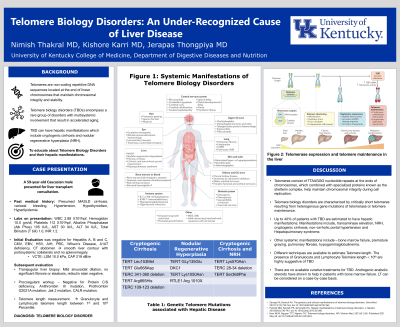Monday Poster Session
Category: Liver
P3077 - Telomere Biology Disorders: An Under-Recognized Cause of Liver Disease
Monday, October 28, 2024
10:30 AM - 4:00 PM ET
Location: Exhibit Hall E

Has Audio

Kishore Karri, MBBS, MD
University of Kentucky
Lexington, KY
Presenting Author(s)
Award: Presidential Poster Award
Nimish Thakral, MD1, Kishore Karri, MBBS, MD1, Jerapas Thongpiya, MD2
1University of Kentucky, Lexington, KY; 2Texas Tech University Health Sciences Center, Lubbock, TX
Introduction: Telomeres are non-coding repetitive DNA sequences that protect the ends of chromosomes by discriminating natural ends from regular incidental DNA breaks. Telomere biology disorders (TBDs) encompass a rare group of disorders with multisystemic involvement. TBDs are commonly associated with mutations in TERT, TERC, and DKC1 genes. TBDs are increasingly being recognized as a cause for liver disease which would otherwise previously be categorized as idiopathic. Here we present a case of non-cirrhotic portal hypertension with underlying TBD.
Case Description/Methods: A 58-year-old male with a previous diagnosis of cryptogenic cirrhosis decompensated with variceal hemorrhage presented for liver transplant evaluation. Initial workup was negative for Hepatitis A, B and C, CMV, EBV, HSV, Autoimmune Hepatitis, Alpha 1 Antitrypsin deficiency, and Wilson’s Disease. Liver enzymes on review were historically unremarkable. Imaging studies showed coarsened hepatic architecture with splenomegaly. However, he had undergone US elastography previously which showed a shear wave speed of 1.63 m/s, thus ruling out advanced fibrosis. Liver stiffness was re-evaluated with a fibroscan which showed a liver stiffness median (LSM) of 10.0 Kpa indicating F2-F3 fibrosis. Subsequent liver biopsy showed sinusoidal dilation without any appreciable fibrosis.
Given the unclear etiology of portal hypertension, pro-coagulant workup was done which later returned as unremarkable. Therefore the possibility of TBD was entertained. Telomere length analysis revealed lymphocyte telomere length between 10-50% and granulocyte telomere length between 1-10%, thus establishing the diagnosis of TBD.
Discussion: TBD is an accelerated aging syndrome resulting in premature aging of organs that have a high cellular turnover such as bone marrow, skin, and gastrointestinal tract. Hepatic involvement is frequent and manifests as TBD-related cirrhosis or nodular regenerative hyperplasia (NRH) Interestingly, our patient did not have cirrhosis and reticulin stain did not show signs of NRH either. Hepatic manifestations have been reported in up to 40% of the patients with TBD. Therapeutic options are limited with androgens having shown promising results. Hepatologists must be aware of this association since awareness and detection of the true burden of TBD-related liver disease are key to the development of further therapeutic modalities.
Disclosures:
Nimish Thakral, MD1, Kishore Karri, MBBS, MD1, Jerapas Thongpiya, MD2. P3077 - Telomere Biology Disorders: An Under-Recognized Cause of Liver Disease, ACG 2024 Annual Scientific Meeting Abstracts. Philadelphia, PA: American College of Gastroenterology.
Nimish Thakral, MD1, Kishore Karri, MBBS, MD1, Jerapas Thongpiya, MD2
1University of Kentucky, Lexington, KY; 2Texas Tech University Health Sciences Center, Lubbock, TX
Introduction: Telomeres are non-coding repetitive DNA sequences that protect the ends of chromosomes by discriminating natural ends from regular incidental DNA breaks. Telomere biology disorders (TBDs) encompass a rare group of disorders with multisystemic involvement. TBDs are commonly associated with mutations in TERT, TERC, and DKC1 genes. TBDs are increasingly being recognized as a cause for liver disease which would otherwise previously be categorized as idiopathic. Here we present a case of non-cirrhotic portal hypertension with underlying TBD.
Case Description/Methods: A 58-year-old male with a previous diagnosis of cryptogenic cirrhosis decompensated with variceal hemorrhage presented for liver transplant evaluation. Initial workup was negative for Hepatitis A, B and C, CMV, EBV, HSV, Autoimmune Hepatitis, Alpha 1 Antitrypsin deficiency, and Wilson’s Disease. Liver enzymes on review were historically unremarkable. Imaging studies showed coarsened hepatic architecture with splenomegaly. However, he had undergone US elastography previously which showed a shear wave speed of 1.63 m/s, thus ruling out advanced fibrosis. Liver stiffness was re-evaluated with a fibroscan which showed a liver stiffness median (LSM) of 10.0 Kpa indicating F2-F3 fibrosis. Subsequent liver biopsy showed sinusoidal dilation without any appreciable fibrosis.
Given the unclear etiology of portal hypertension, pro-coagulant workup was done which later returned as unremarkable. Therefore the possibility of TBD was entertained. Telomere length analysis revealed lymphocyte telomere length between 10-50% and granulocyte telomere length between 1-10%, thus establishing the diagnosis of TBD.
Discussion: TBD is an accelerated aging syndrome resulting in premature aging of organs that have a high cellular turnover such as bone marrow, skin, and gastrointestinal tract. Hepatic involvement is frequent and manifests as TBD-related cirrhosis or nodular regenerative hyperplasia (NRH) Interestingly, our patient did not have cirrhosis and reticulin stain did not show signs of NRH either. Hepatic manifestations have been reported in up to 40% of the patients with TBD. Therapeutic options are limited with androgens having shown promising results. Hepatologists must be aware of this association since awareness and detection of the true burden of TBD-related liver disease are key to the development of further therapeutic modalities.
Disclosures:
Nimish Thakral indicated no relevant financial relationships.
Kishore Karri indicated no relevant financial relationships.
Jerapas Thongpiya indicated no relevant financial relationships.
Nimish Thakral, MD1, Kishore Karri, MBBS, MD1, Jerapas Thongpiya, MD2. P3077 - Telomere Biology Disorders: An Under-Recognized Cause of Liver Disease, ACG 2024 Annual Scientific Meeting Abstracts. Philadelphia, PA: American College of Gastroenterology.

